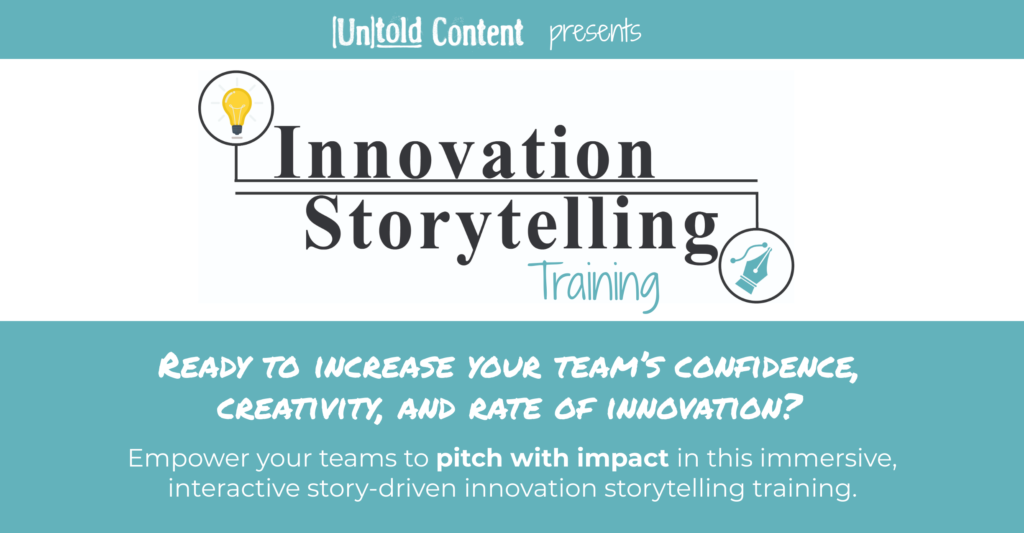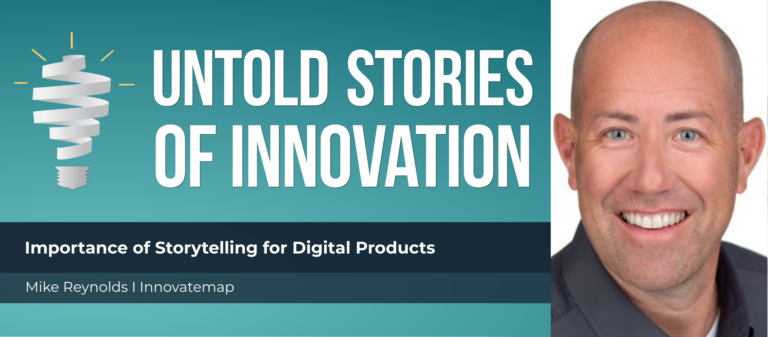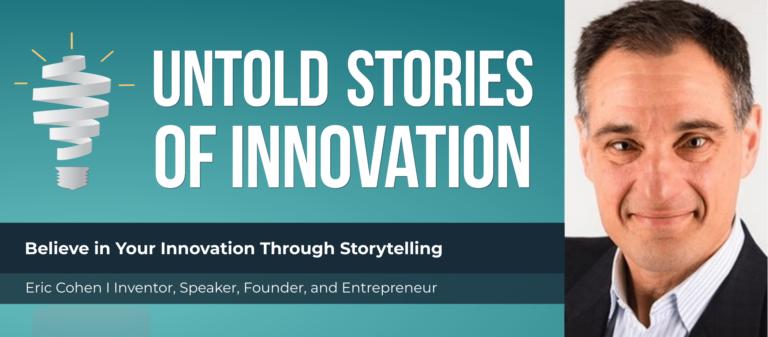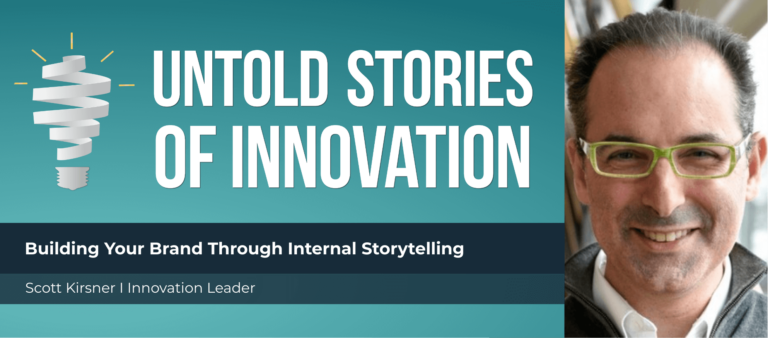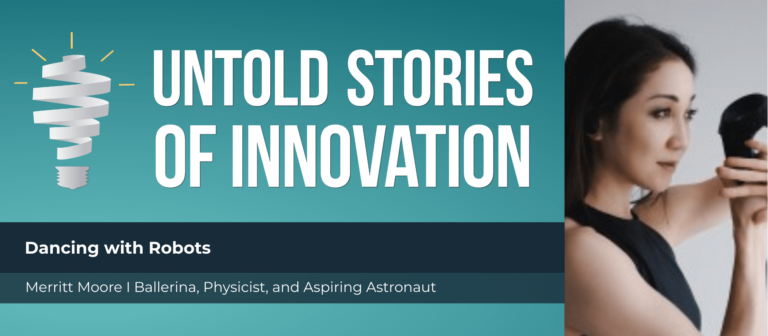Corporate Culture Innovation with Darrin Murriner & Kirsten Moorefield of Cloverleaf
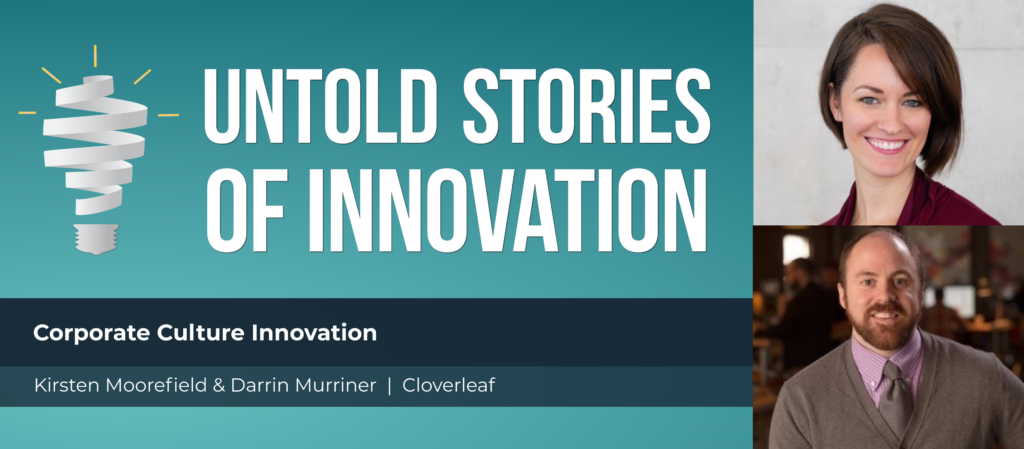
Untold Stories of Innovation
“If we talk about a team experience they've had and people tell us their own stories, then we can insert our story within that. That's when people really understand what we're doing, why it's important, and why they need it themselves.” —Kirsten Moorefield, COO & Co-Founder at Cloverleaf
From today’s episode in Corporate Culture Innovation you’ll learn:
Why do stories matter to the innovation process? What values can be instilled in innovators who share stories? How do innovation leaders inspire creators to tell and share their success and failure stories? We speak with Darrin Murriner & Kirsten Moorefield, co-founders of Cloverleaf, a tech startup creating seamless collaboration among teams using behavioral insights and streamlined communication across platforms. When it comes to cultivating corporate culture or sharing innovative ideas, Kirsten and Darrin discuss how storytelling is the key to maximum impact. After all, what good is an innovative idea without a good story?

Darrin Murriner is CEO and Co-Founder of Cloverleaf, a comprehensive personal and team development tool. Cloverleaf integrates with the tools employees use everyday such as email, calendars and Slack to provide customized coaching content that improves performance. Darrin is also the author of Corporate Bravery, a book about eliminating fear-based decision making and transforming corporate cultures into places where people can do their best work and be engaged. He has applied his 15 years of experience as a Finance, Operations and Risk Management executive in Fortune 500 global companies to his entrepreneurial endeavors in the world of startups.

Kirsten Moorefield is Chief Operations Officer and Co-Founder of Cloverleaf, a tech startup whose mission is to transform every team into a thriving team of people who are empowered and engaged. As a TEDx speaker and female founder, Kirsten is passionate about spreading the power of relationships and empathy in effective and energizing work.
untoldcontent.com/trainings/innovation-storytelling-training
TRANSCRIPT
This episode, Corporate Culture Innovation is powered by Untold Content’s innovation storytelling training. Increase buy in for your best ideas in this immersive and interactive, story-driven experience. Where your teams refine storytelling techniques for their latest projects, prototypes and pitches—and get inspired by 25 epic examples of impactful innovation stories. Learn more at https://untoldcontent.com/innovationstorytellingtraining-2/.
Katie: Welcome to Untold Stories of Innovation, where we amplify untold stories of insight, impact and innovation. Powered by Untold Content, I’m your host, Katie Trauth Taylor. Our guests today are Darrin Murriner and Kirsten Moorefield. They are co-founders of Cloverleaf, Darrin is CEO and Kirsten is COO. Welcome to the podcast.
Kirsten: Thank you for having us.
Darrin: Yeah, thank you.
Katie: I’m so honored to have both of you. You’re part of a really incredible startup. Would you tell us a little bit more about Cloverleaf?
Darrin: Sure. Kirsten, why don’t you — I’ll let you kick that one off.
Kirsten: Okay, sure. So Cloverleaf, we’re an automated coaching platform. We scale coaching to the entire organization. So we’ve partnered with assessment companies like DISC, StrengthsFinder, so that people can come and learn about themselves, grow their self-awareness. And then from there, we integrate into tools that people use every day. So your email, your calendar, your Slack. And we push coaching to you about yourself. How can you do your best work? But also about your teammates, so how can you best persuade them? How can you turn some of those conflict triggers into opportunities to improve the problems that you’re solving on your team? And we also scale it up to tools for managers on how to better lead their teams, create projects that people are really skilled in. And then also we scale it up to enterprise features on, how do you really manage your entire talent base that you have, whether it’s, you know, 40 people or 400,000 people spread across the globe? So that’s a quick intro to what we do.
Katie: I love it. And Darren, you’re the author of a book called Corporate Bravery. Could you share how some of the insights from Corporate Bravery really embed into the mission of Cloverleaf?
Darrin: Yeah. So I wrote that book at the end of my corporate career, and really just kind of talking about my experiences. Like a common theme that I experienced over a 15 year career was that a lot of times decision-making in a corporate context — I think this is extremely relevant in our current environment — is oftentimes just made out of fear. And so those observations really kind of led me to write a book about culture, and specifically about how to eliminate fear in that decision-making process. And the funny thing was, I wasn’t — I didn’t write it with the idea that it would be a precursor to Cloverleaf. I did get to the end of that and I felt a little bit empty and just kind of said like, well, I kind of pointed out all these issues. And I did give some suggestions on how people can kind of overcome that fear-based kind of culture. But I was really kind of just pushed to kind of say, like, where can I create solutions that can help people take this — now that they’ve identified this — into a way to transform their culture. And I hadn’t really made that connection, but continued down the path towards creating Cloverleaf. And I had a really kind of clear moment where I was talking with our marketing manager at one point about content. Like where can we find some content to put into shareable pieces that we could share through our social channels. And I was like, oh, I should go back and look at the book and see if there’s some things that — there’s at least a couple of chapters that I could think of that would be some really great content. I kind of went back through and was going through the things that I had written and was like, oh my gosh. Like, this is really a blueprint for what we ended up building at Cloverleaf. And I had never made the connection between those two things.
Katie: Yes. As I’ve learned more about Cloverleaf over the last year, I see this really incredible way of helping people understand themselves and understanding the people that they work with. And there’s a level, I think, definitely of culture creation that is an output of that effort. Right.
Darrin: Yeah, absolutely. I mean, culture is such a weird thing, right? Because everybody has a bit of a different definition about what culture means to them. You know, in some cases, it’s they might think it’s pingpong tables and beer kegerators. And the reality is it’s we each bring our own set of kind of behaviors and values and assumptions. And every time we add someone to that mix, it changes the culture. And, you know, we oftentimes think of like Procter & Gamble as having like a specific culture. And the reality is, it’s the individual employees’ experience with the teams that they’re a part of. And that was something that was very formative for Cloverleaf. This idea that every team has its own culture and those aggregate to a larger organizational culture. But if you don’t create those experiences for individual employees on a daily basis, and really craft and create that culture at the team level, that’s ultimately the experience that the employee has. And it’s less so crafted from some edict on high and, you know, value statements that are hung in a hallway, and it’s way more about just the daily decision making that happens at that team level.
Katie: Corporate Culture Innovation- So, Kirsten, tell me about your perspective as COO, especially as you’re sort of managing — well, I’m sure both of you are managing the team inside your startup. But do you guys use your products?
Kirsten: Corporate Culture Innovation- Oh, my gosh. Absolutely. So at the time of this recording, basically, the whole world has gone remote because of COVID-19. And our team is part of that. We went remote last week and I just had a one-on-one yesterday with one of our team members who’s working remote for the first time ever. And, you know, he said, I’m sitting in this one room for so many hours in one day and I am struggling to feel motivated. So I pulled up his Cloverleaf profile and we looked at, you know, what are motivators for him, what are stressors for him, and what are things that he can do that he can build into the structure of his day to bring humor or to bring quick wins or things that specifically to him are going to bring him energy and make him feel like his day is a success. Because, you know, somebody else on our team was like, well, I have no issue with this. I just sit down in the morning, I work for four hours, I get up, I have lunch, and then I finish my day. And that, unfortunately, is not how everybody works. And so we are using our own platform a lot right now to coach our team on, how do we feel connection and how do we each feel motivated in this incredibly different time of rapid change?
Katie: Corporate Culture Innovation-Yes, it seems to me that right now, as we’re going through this pandemic and this crisis, that a tool like this, like Cloverleaf could actually be a really, really powerful solution to help you stay aware of your team’s identity. You know, who your people are and what they’re struggling with. It can invite that conversation.
Darrin: Corporate Culture Innovation-The other interesting thing about that, too, is that I think it also gives us an opportunity to build authentic relationships with each other as well. Because, I mean, at least in our team, you know, we’ve created an environment where people can feel comfortable sharing really vulnerable things. And so people talked about some of their emotions, you know, like feelings of depression or feelings of isolation or loneliness. And, you know, those are opportunities for us to step up as leaders and as team members to build trust with each other in a way that goes beyond just how we can work better together in a team, but in a way that creates loyalty and trust in a way that we would never be able to create, you know, just in a normal kind of day-to-day environment.
Katie: Corporate Culture Innovation-I think so many of us in the corporate world or in the, you know, as professionals, we’re exposed to different ways of understanding our best work situations or, you know, just how we work well and best. And so tell us about some of the measures — you mentioned a couple of them. StrengthsFinder, for instance, we’ve done that with our team at Untold Content. We’ve also done the Harry Potter Pottermore quiz to make sure we know which house we would be sorted into. So tell us a little bit more about some of the different assessment tools that you’ve partnered with in order to create that sustained movement from awareness into coaching and team-building out of that.
Kirsten: Corporate Culture Innovation-Yeah, Katie, we’re definitely happy to talk about that. But first, and incredibly more importantly, is, did it change your team dynamic to understand which Harry Potter house you would be in?
Katie: Corporate Culture Innovation-You know, yes. So it’s funny. All houses are represented on the Untold Content team. And it led to a very vibrant discussion about how Slytherin is not necessarily a negative house.
Kirsten: Corporate Culture Innovation-I was going to ask about Slytherin. Who’s in Slytherin and how’d that play out?
Katie: Corporate Culture Innovation-Yes, our head of research writing is in Slytherin. She’s incredibly detail-oriented, meticulous, researcher. And so that makes sense a little bit, right. Like Slytherins are quite brilliant. And they also take — you know, perhaps they don’t make the right choices in the end, but they do see the ethical implications of their actions. Anyway, she’s a wonderful person. Not at all someone who would make bad choices when it comes to ethics. But, yes, it’s really interesting, you know, to see. Quite a bit of our team is Ravenclaw. So, yeah, I think overall we laugh about it, but it’s sort of a bonding thing. When anyone new enters the company, we ask them to take the quiz and find out what house they’re in.
Kirsten: Corporate Culture Innovation-Oh, my gosh, that’s so fun. And I think that’s actually a perfect segue into some of the tools that we use. Not that we use Harry Potter — yet.
Katie: Corporate Culture Innovation-You really need to think about this.
Kirsten: Corporate Culture Innovation-I know, you’re right. You’re right. I’ll think hard about it. But, you know, the way that you talked about Slytherin is so interesting and really similar to the ways that we find people having epiphanies inside of our platform. Because really the tools that we use help you see different thinking styles and different ways of operating. And there are clashes that different styles can have that we tend to think go back to character, such as, you know, you would think Slytherin makes bad decisions — which in Harry Potter, that’s up for debate. But in real life, the different thinking styles are actually really good opportunities to partner better to solve problems in more effective and lasting ways. And so we’re really trying to expose some of those things that you might take as a jump to judging character are actually strengths that the other person has, like being detail-oriented instead of jumping to conclusions, for example.
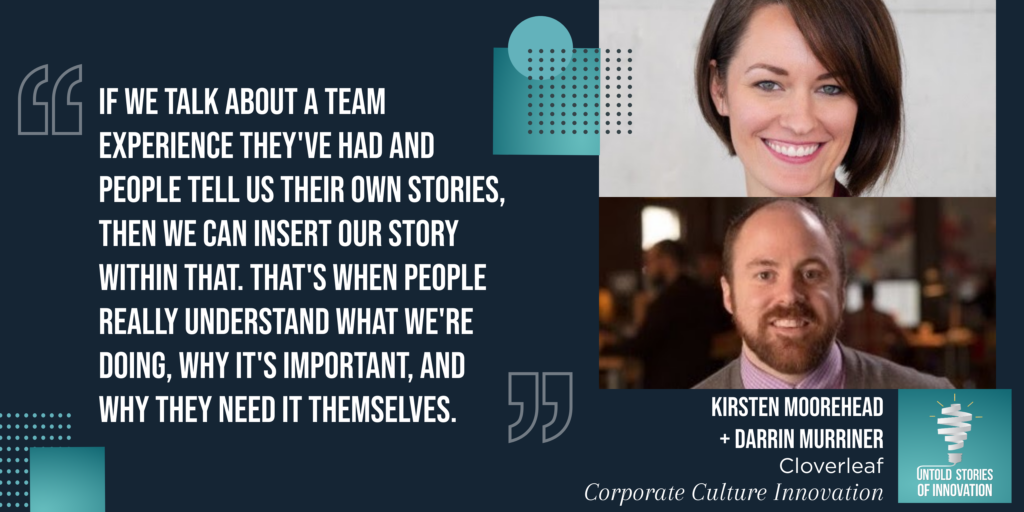
Katie: Corporate Culture Innovation-Yeah.
Kirsten: Corporate Culture Innovation-So really the tools that we partner with, we’ve got a DISC on the platform. We have 16 types, which is based on Carl Jung’s research, like Myers Briggs. We have StrengthsFinder. We have VIA Strengths, which is actually based here in Cincinnati, but it’s a global strengths assessment. And we have Culture Pulse based off of Geert Hofstede’s research on different cultures. And really that one comes a lot down to, how do you like to be managed, and how do you prefer to approach your work, as well as motivating values? And, Darren, did I miss one in there?
Darrin: Corporate Culture Innovation-I feel like Enneagram, yeah.
Kirsten: Corporate Culture Innovation-How could I forget Enneagram?
Katie: Corporate Culture Innovation-I was going to ask about Enneagram, but I don’t want to put you on the spot because it’s got so much buzz about it these days.
Kirsten: Corporate Culture Innovation-Yeah. Enneagram is really interesting because many of the other assessments are measuring your behavior. And so not — people like to call them personality assessments, but really they’re measuring behavior. But Enneagram is measuring your deeper motivations, so, why is it that you do what you do? And it’s like the 80 foot deep well, I mean, you just keep going — I shouldn’t say 80 foot, 8,000 foot deep well. It just keeps going deeper and deeper the more you want to get into it. But we’ve taken a particular approach in, how does it apply to work and how can you partner people together really effectively respecting those different motivations and things that are important to people?
Darrin: Corporate Culture Innovation-You know, the other thing I’ll add to that, too, is, you know, it’s really less about the assessments. I mean, it’s just a way to quantify some of those components that are oftentimes hidden for people. I think really the focus when we think about kind of team performance and individuals working together, we find that there are really three key areas that we are able to really help teams and organizations solve. I think the first is communication. And oftentimes it’s misunderstandings and mistrust. You know, just because someone operates differently doesn’t mean that there are ulterior motives. And really kind of calling that out in a way that is valuing those differences in terms of their approaches really kind of helps eliminate some of those misconceptions or misinterpretations of how things are being communicated or how communication is being processed. So communications, a big piece of that. Trust is the other thing. Right. Because the more transparency, the more openness that you have, the more that you can promote that, the more trust is actually established over time. So I don’t have those misconceptions, I don’t have those misperceptions that actually erodes trust over time. And the third piece is really just kind of role clarity. What am I naturally wired to — what kinds of work am I actually wired to do? And is the role that I’m being put into on a daily basis — or, you know, even even on a really functional role basis, like if I’m a salesperson or I’m a software engineer — is that role defined in a way and are the expectations such that I can actually be successful? And not only be successful in the role, but also feel engaged and empowered? Because we want people to walk away from their work on a daily basis feeling like not only were they able to contribute something of value, but they were able to do it in a way that actually gave them energy. And that spills over into their personal life as well.
Katie: Corporate Culture Innovation- Yes, absolutely. So it’s really — to me, I keep thinking of the power of reflection, too. You mentioned communication and in particular, it seems self-reflection and the ability to know who you are and know who other people are and be able to talk about that very transparently. I love how you draw the line between that and the connection to trust.
Darrin: Corporate Culture Innovation- Yeah, and I mean, trust is such a complex issue. You know, even power dynamics come into play and like, we’ve got a lot of really cool things and a roadmap to, you know, help bring some transparency to that trust process and help people either build on trust or avoid eroding trust over time. Because it really is such an important component of team cohesion and team performance.
Katie: I want to ask you both — because you’ve been innovating in this space — what role do you feel that storytelling plays in the innovation process, especially from the startup founder’s perspective?
Kirsten: I think it’s huge. I think it’s huge because when you’re doing something that doesn’t have a clear name, you know, like at the beginning of this, you’re asking, hey, tell us about Cloverleaf. We’ve tested out 17,000 different ways of saying, we’re a coaching platform, we’re a team-building platform, you know. Like there’s really no clear just three letter phrase that explains what we’re doing. And so being able to tell a story around it is what really helps people understand how it works. If we just talk about the nuts and bolts and the features, people get lost. But if we talk about, you know, a team experience you’ve had and we get actually people telling us their own stories, and then we can insert our story within that, that’s when people get the light bulb moment and really understand what it is that we’re doing and why it’s so important and why they actually need it themselves.
Darrin: Yeah, even in the sales process, oftentimes, you know, it’s pretty easy to focus on features and components of the technology itself. And time after time after time, we can have the best features in the world and we can sell on those features. But it’s the stories that we tell — our own experiences or experiences from our clients — that ultimately push people towards, oh, this is something I want to buy. And I think it’s that emotional connection. And that’s on the sales side. But even in the startup phase — and Kirsten mentioned, you know, we’ve tested a lot of different elevator pitches about what our product is — people want some sort of framework to put it into. You know, they want a model that they’re familiar with to be able to put our product. And in the early days when the product didn’t have a lot of those features and capabilities, you have to sell the vision of what it is that the technology can do over time. And that’s just always a hard place to be. You know, on the sales side, I need to sell the thing that I actually have today, but also still need to cast vision, whether that’s for investors or for, you know, our clients about where this product could take their organization or how it could help them solve some really challenging problems on the talent management side that maybe they’ve struggled with for years or decades. So storytelling is a huge aspect of getting to where we are at today. And it’s going to be even more important. I think Kirsten and I talk more about storytelling and communication now than we did when we were in an accelerator and had to focus on that more or less full-time for a demo day pitch.
Kirsten: Yeah, absolutely.
Katie: Why do you think that that’s — why do you think storytelling has become increasingly important as your business has grown?
Kirsten: I think part of it is internal. Because, you know, we have like, for example, our developers never talk to our clients. And so being able to tell those stories internally helps unite our whole company around what we’re doing and why it matters and the impact that it already is having. So as we grow the company, you know, that just becomes important internally to keep everyone focused. But I think also externally, we’ve got a really good product and people know that. And so we don’t have to keep trying to — like as Darrin said, in the early days, it was just trying to sell the vision. And now the vision is here and it’s real, and so people can experience that. And so what we’re really having to do is spread the awareness, and story is so much more effective for doing that and focusing on our why and on the overall impact and the real-life stories around that. That’s how we really can spread the news and help people see why it matters and how they can personally be involved in it.
Katie: Okay, so let’s hear — can we hear some of the stories that you share now with clients, or that you hear from clients that you say, oh, I’m going to note that and share it on a future sales call?
Darrin: Oh, gosh. Where do I begin? So one of the really cool features that we have in our product — and it’s the one thing that I think we get people most excited about or that they get most excited about and want to communicate to us — is our integrations that we have where we push those coaching messages out to people. And, you know, we don’t — despite what people might think about AI and, you know, how much power of predictive capability AI has — you know, we can’t always just craft the surreal moments that happen in terms of the timing when they get certain messages about certain people. But we get regular messages like, oh, my gosh, I got your coaching insight about this person right as I was about to walk into that conversation about pay. And, you know, every time I have a pay conversation, it just goes negatively. I walk out disappointed and, you know, feeling like that was a failure. And this time I got your coaching tip, and it was about, you know, it wasn’t even about pay. Right. It was just more about behavioral and how to — I think this specific example was more about just pacing and how they craft the message and how they’re thinking about communicating. And it gave her — gave this particular person — just enough insight to be conscientious about it as she was walking into that conversation. She was like, it was the best conversation I had about pay in my entire career. And we get those kinds of stories on a daily basis.
Kirsten: We actually also have one of our own. There was a time actually a couple of years ago when that feature was still just in beta, and I was trying to convince Darrin of something. And I was starting to get frustrated because I respond to things with emotion and with thinking about theories of, you know, what does this — how does this impact the next three years of our company, and that kind of stuff. And I had a meeting scheduled with Darrin one day to have yet another conversation about something I thought was really important. And I got a tip in the morning and it said, don’t convince Darrin with theories and emotions, but focus on facts. And so I just —
Katie: Oh, my goodness.
Kirsten: I know. And I was like, wow, if I think back through, saying, I’m overwhelmed, this is important for the future, I realize that is all emotions and theories. So I just — I took the exact same information and I literally just made a bullet point and then I put it on the whiteboard for him. And we had the most productive conversation and ended up coming to a really good, productive conclusion together that we both were really happy about. And even today, we still talk about the importance of that decision we made. And it was from our own product. It was really — it was just a surreal moment. It was really cool.
Katie: I love that example. That is so powerful. And I’m thinking of the earlier story you shared, too. Now that we’re all transitioning into new ways of working in light of this pandemic, and you were able to pull up some insights from one of your team members and adapt your advice based on some of the concerns that he might have in his struggle to start remote work. It’s so — really moving.
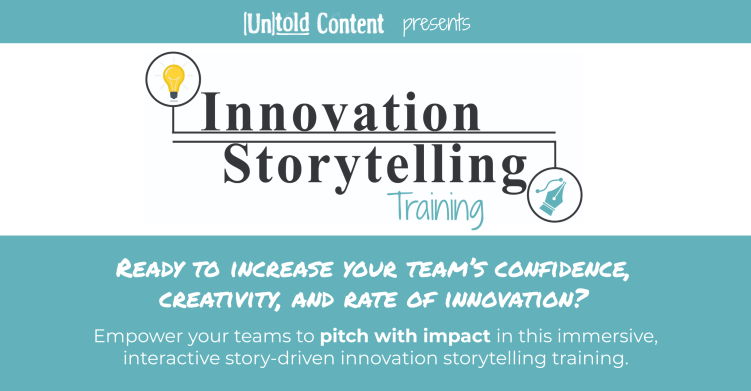
Kirsten: I think one of the cool things about our platform is it is so human. I mean, it’s a technology platform, but it’s based off of psychology data and it’s all about humans and how do we work and how can we be fulfilled and energized. And so we actually have endless stories about it. And Darrin and I are just trying to figure out more ways to tell it, like the TED talk that I just did or like our e-mail campaigns that we work on. How do we make them not about features, but about, hey this person had this experience, you could have it, too — by the way, with this feature. You know, just building story into really everything that we do.
Katie: This is a trend in some of these podcast interviews we’ve been — as I’ve been chatting with different thought leaders in the innovation space, something that’s come up is the relationship between experience and story. And so it’s not really — you know, it’s a little bit harder to think about story when it comes to just articulating product specs and some of the features, like you mentioned. But when you’re trying to express the experience or the emotional relatability of a product and how it’s going to improve your work life, the story can have such a bigger impact. So there’s, I think, a relationship there we need to keep diving into when it comes to, if you are as a brand leaning into the experience you’re trying to create for consumers or users, think about how you can use story as a way to express that experience.
Darrin: Yeah, I think that’s especially true for tech products, too. You know, there are definitely ways to do that with consumer products that you’d buy off the store shelves, but with a tech product, you know, you can control that entire experience from the time that they are creating an account and they have to put an email address in as a way to log back in, all the way through, you know, each value point to the first time they use it all the way through to the five hundredth time that they use it. And, you know, being really intentional about that, I mean, it’s something that we’re trying to grow in as a company because we don’t — you know, we didn’t have experience as great tech product builders. You know, we’re kind of learning it as we go. And thank God, we’re curious and, you know, we’re excited to test and see how people respond to certain things that we do. But it is extremely important, that intersection of story and the text and the content that we put around the experience that the user has as they navigate through our product to get to value. Those two things very much work in symmetry. And it’s things that we’re learning and growing in every day with our product as well.
Katie: So what you’re saying, it’s triggering an idea in my mind about how we are all at this point trained to be agile and to be lean startups or lean innovators. And the way that we approach storytelling, sometimes, is not so lean. It’s not so experimental. It’s not so much about getting user feedback. And I think that’s something that our team at Untold, we’ve really learned over the years, especially as we’ve been exposed to agile methodologies and lean startup methodologies, that the way that we practice story, we really shouldn’t just spend, you know, tons and tons of resources on getting one story to be perfect, but really go out there and test our stories and see and ask for feedback on our storytelling strategies, as well, so that we can continue to adjust them, pivot, and learn from them.
Kirsten: Amen, Katie. I’m totally with you on that. And that’s actually one of the cool things about — again, as Darrin said — being part of a tech product, is that we get to use really cool tools nowadays, like Intercom or like Google Optimize or some of these tools that allow you to go into the technology and actually change the wording and A/B test which one gets a better click through rate, which one gets a better purchase rate, all of that kind of stuff. So I think that this is actually a really cool time where you can test out different messaging — which is basically just shorter versions of stories — and see which one really actually drives to behavior and impacts people and hits home for them.
Katie: Yeah, absolutely. I love that. Thanks so much for sharing the technical, you know, the technical aspects of how we can keep thinking about doing that. So, you know, we’ve chatted about the role that storytelling can play in the success of your startup and for your consumers. What about for you personally as innovators, when you get the story right, when it resonates, what sort of impact — or when you don’t, when it’s perhaps a failed technique — how do you adapt to that? What are some of your feelings around the role that storytelling plays in your motivation as an innovator?
Darrin: Yeah, I think one of the places I see that play out the most for us is in fundraising. Because, you know, oftentimes you are in front of an investor or a couple of investors and, you know, you have to communicate a lot in that 30 minutes or that 60 minutes. Right. You have to talk about the market, you have to talk about your unique proposition in that market, you have to talk about traction, and why you’re the right team to be a part of that. And I think that is an area where we have seen consistently that, you know, sometimes — and you can tell right away those investors that that story is connecting with. And oftentimes, I think it’s the ones that — at least for us, in our experience — it’s the ones that have an already pretty established belief about the world of work and how we can make a difference in terms of people’s experience in the workplace and the impact that that could have, not just financially, right, for the investors’ returns, but also the impact that it can have on communities and on societies and on individual organizational cultures. And those are the ones that typically we — and I don’t think we always started from that place. You know, in the early days of fundraising, that’s not how we crafted our conversation, you know, our pitches to investors. But I think over time — and part of that is maybe just confidence or, you know, hey, once you’ve actually had some successes, it’s easier to talk from that standpoint. But I think if we could have done it over — like knowing what we know now — I think really trying to connect with the people who buy into that, so that we’re communicating a message that connects with them emotionally in a way that is different than just dollars and cents.
Katie: Yes, absolutely. I think the investors — more and more — I think there’s an awareness that people invest because — not only because of the promise of the return, right. They want to be mentors, especially for tech startups. And certainly all of the financial aspects of investing are there. It’s just that especially in the tech world, there’s usually a passion or a personal connection that’s sort of part of their investment thesis.
Darrin: Yeah, I mean, ultimately, the person on the other end of that pitch, I mean, they’re seeing hundreds of these pitches regularly. So it has to be something that resonates with them personally. And, you know, the only way that I think you could do that is to really draw on the emotion of, you know, their own personal experiences or their own thought patterns and thought processes and in their own kind of expectations about, you know, what kind of a career they want, what kind of an impact that they want to have in the world. So, yeah, it’s been an interesting — and I feel like when Kirsten and I have those conversations about our story and our brand and how it’s resonating, it typically comes from a conversation with an investor.
Katie: You know, something else that’s so powerful about Cloverleaf, you’ve been able to not only get investor support, but also get quite a few government grants as well. Right.
Darrin: Yeah. I mean, I think, you know, the nice thing about our product is it’s pretty universal. It doesn’t have to be industry-specific and it doesn’t have to be — you know, it’s the business of people. And whether you’re the Department of Defense and, you know, you’re leading and training people in a very regimented, control-type process or culture, or you are a small local nonprofit, you know, in middle America. It’s still about people and it’s about motivating and it’s about creating opportunities and it’s about aligning personal expectations with that of the organization. You know, that doesn’t change. And so we definitely are able to do government work right alongside, you know, large corporations or small nonprofits. It really doesn’t matter. And we’ve built a product in a way to be extremely agile. So, you know, whether it’s a small team and that small team grows to several thousand people, we still have — the product is flexible enough to accommodate all ends of that spectrum.
Katie: And I know it’s not your central go-to-market strategy, but I would love to see this — a version of this — for families, as well.
Darrin: That’s so funny. Our VP of sales just posted his coaching insight on his wife this morning. And actually, he didn’t post the actual insight. He posted the text message exchange that he had with his wife. And actually, I think she was the one that received it and had messaged it to him. And there was an exchange and he just screenshotted his entire text message exchange and posted it on there. And we actually hear that a lot. My wife actually got something on me recently. And it talked about how I process disappointment. Right. Like, I have expectations about something happening. And when I get that news and I process it, that I just need — I need time and space to be able to kind of deal with the disappointment that happens there. And it was really insightful for her. She was like, this completely changes how I would approach situations where there is disappointment in your life. And so we’ve seen it, not only personally, but we’ve even had clients offer it as a benefit to their employees that like, hey, go ahead and spin up your own family teams and really encourage that, because they understand that if their personal relationships are strong, then they’re going to be more engaged in the work that they’re doing.
Kirsten: And the funny thing about that is, Darrin’s been married to his wife 17 years now. Is that right, Darrin?
Darrin: 17 years, yeah.
Kirsten: Yeah. And so 17 years in, an automated coaching tip gave her a great epiphany about her husband. So real quick, shameless plug here. Actually, if you sign up for a small team plan, it comes with an hour long coaching session. So we actually highly encourage families to sign up together and receive a session led by a professional coach on how they can operate really well together. It’s cheaper than marriage counseling.
Katie: I love it. I love it. This is incredible. I love these stories that you’ve shared, they really do speak to the impact that this work that you’re doing can have on all of us, whether that’s at a family level or, of course, in our professional lives. So thank you so much for sharing all of these strategies and for sharing insight into how you’ve pivoted and changed and learned about your storytelling process. I just think it’s especially important as we use storytelling as a way to understand one another and to reflect on ourselves as well.
Darrin: Thanks for having us on, Katie. Really appreciate the conversation.
Kirsten: Absolutely. Thank you, Katie.
Katie: Where can everyone find you on social media?
Darrin: You can — I think on most of our social channels it’s @cloverleafme. So that’s both Instagram and Twitter, LinkedIn, obviously, for professionals. You can find us there. Just search for Cloverleafme, as well. And then our website is cloverleaf.me, so not dot com. And they can obviously learn a lot more about the personal plans and the team plans that Kirsten mentioned, or even about how we serve coaches and consultants and enterprises, as well.
Katie: Wonderful. Thank you both so much for being on the podcast today.
Kirsten: Thanks, Katie.
Darrin: Thanks, Katie.
Katie: Thanks for listening to this week’s episode. Be sure to follow us on social media and add your voice to the conversation. You can find us at Untold Content.
You can listen to more episodes of Untold Stories of Innovation Podcast.
*Interviews are not endorsements of individuals or businesses.

